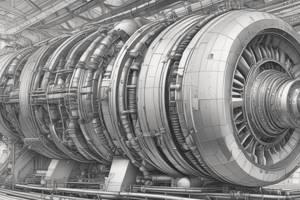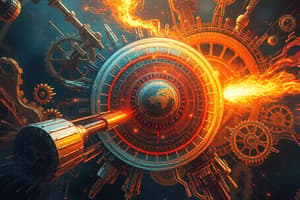Podcast
Questions and Answers
What is the correct expression for work done on an object?
What is the correct expression for work done on an object?
- W = F × s × sin(θ)
- W = F × s × 1
- W = F × Δt × cos(θ)
- W = F × s (correct)
Which of the following correctly defines the coefficient of performance (COP) for refrigerators?
Which of the following correctly defines the coefficient of performance (COP) for refrigerators?
- COP = Q_L / W (correct)
- COP = Q_H / W
- COP = Q_L / Q_H
- COP = W / Q_L
According to Coulomb's Law, what factors affect the force between two point charges?
According to Coulomb's Law, what factors affect the force between two point charges?
- The difference of the charges and the square of distance between them
- The product of the charges and the square of the distance between them
- The sum of the charges and the distance between them
- The product of the charges and the distance between them (correct)
What equation represents Simple Harmonic Motion (SHM)?
What equation represents Simple Harmonic Motion (SHM)?
Which law relates the angles of incidence and refraction for light passing between two media?
Which law relates the angles of incidence and refraction for light passing between two media?
What is the expression for kinetic energy for a moving object?
What is the expression for kinetic energy for a moving object?
In thermodynamics, which law states that energy cannot be created or destroyed?
In thermodynamics, which law states that energy cannot be created or destroyed?
What is the formula for calculating the efficiency of a heat engine?
What is the formula for calculating the efficiency of a heat engine?
Flashcards are hidden until you start studying
Study Notes
Key Concepts in Physics (UP Board Class 12)
Mechanics
-
Newton’s Laws of Motion:
- First Law: A body remains at rest or in uniform motion unless acted upon by an external force.
- Second Law: F = ma (Force equals mass times acceleration).
- Third Law: For every action, there is an equal and opposite reaction.
-
Work, Energy, and Power:
- Work done (W) = Force (F) × Displacement (s) × cos(θ).
- Kinetic Energy (KE) = 1/2 mv².
- Potential Energy (PE) = mgh (for gravitational potential energy).
- Power (P) = Work done (W) / Time (t).
Thermodynamics
-
Laws of Thermodynamics:
- Zeroth Law: If two systems are in thermal equilibrium with a third system, they are in thermal equilibrium with each other.
- First Law: Energy cannot be created or destroyed, only transformed (ΔU = Q - W).
-
Heat Engines and Refrigerators:
- Efficiency = (Work output / Heat input) × 100%.
- Coefficient of Performance (COP) for refrigerators = Useful refrigeration (Q_L) / Work input (W).
Waves and Oscillations
-
Simple Harmonic Motion (SHM):
- Characteristics: Period (T), frequency (f), amplitude (A).
- Equation: x(t) = A cos(ωt + φ), where ω = angular frequency.
-
Sound Waves:
- Nature: Longitudinal waves.
- Speed in air: v = 343 m/s (approx. at room temperature).
- Doppler Effect: Change in frequency or wavelength due to relative motion.
Electromagnetism
-
Coulomb's Law:
- The force between two point charges: F = k(q1q2/r²), where k is Coulomb's constant.
-
Magnetic Properties:
- Magnetic Field (B): Produced by moving charges and currents.
- Ampere’s Law: ∮B • dl = μ₀I (magnetic field due to a steady current).
Optics
-
Reflection and Refraction:
- Snell's Law: n1 sin(θ1) = n2 sin(θ2).
- Critical Angle: The angle of incidence that results in total internal reflection.
-
Lenses and Mirrors:
- Lens formula: 1/f = 1/v - 1/u.
- Magnification (for lenses): m = v/u.
Modern Physics
-
Photoelectric Effect:
- Emission of electrons from a material when exposed to light.
- Einstein’s equation: E = hf, where h is Planck’s constant.
-
Nuclear Physics:
- Types of decay: Alpha, beta, and gamma decay.
- Fission and fusion processes: Nuclear reactions releasing energy.
Practical Applications
-
Mechanical Properties of Solids:
- Stress and strain concepts.
- Young’s modulus, bulk modulus, shear modulus.
-
Fluid Mechanics:
- Bernoulli’s principle: Relates pressure, velocity, and height in fluid flow.
Laboratory Experiments
- Understanding the concepts through laboratory experiments is crucial.
- Common experiments include measuring resistance in conductive materials, studying oscillation of pendulums, and thermodynamic principles.
Reviewing these concepts should provide a solid foundation for understanding the syllabus of Physics for class 12 under the UP Board.
Studying That Suits You
Use AI to generate personalized quizzes and flashcards to suit your learning preferences.



